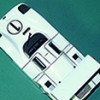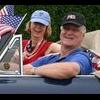Why was Jaguar not in F1 in the '50s?
#1

Posted 14 May 2012 - 15:40
They built the Jaguar D typ that was dominating in sports cars and in these days there weren't that big differences between sportscars and Formula One cars.
Advertisement
#2

Posted 14 May 2012 - 16:06
#4

Posted 14 May 2012 - 16:31
#5

Posted 14 May 2012 - 16:38
Jaguar were in business to make cars - large powerful saloons and sports cars. The racing was an adjunct to this core activity. A development tool and a publicity tool. Basically they had no interest in open wheeled racing.
Enzo Ferrari on the other hand was a racer through and through. The 'production' Ferraris were sold to fund the racing. Maserati made racing cars and sports cars for sale and the factory team was a reluctant addition. Similarly, Cooper and Lotus were in business to sell racing and sports cars.
Edited by D-Type, 10 June 2012 - 08:36.
#6

Posted 14 May 2012 - 16:41
One might ponder whether they could have developed an appropriate engine, given time and budget, but I can't imagine they would (as a company) have wanted to: some discernible connection with their road car product would have been paramount, as David has pointed out.
edit:
Seems I was a bit slow responding - others have already made the same points as me...
Edited by 2F-001, 14 May 2012 - 16:42.
#7

Posted 14 May 2012 - 17:11
#8

Posted 14 May 2012 - 17:26
Ferrari - 19
Aston Martin - 6
Maserati - 5
Jaguar - 4
Mercedes - 3
Lancia - 2
Cunningham - 1
OSCA - 1
Porsche - 1
Edited by Rob Miller, 14 May 2012 - 17:28.
#9

Posted 14 May 2012 - 17:30
Rob Miller, on May 14 2012, 18:26, said:
In the 42 World Championships races in the 50's, ...
Sports Car World Championships, right?
The simple answer to the question in this thread title is that Bill Lyons was too sensible, too commercial, too realistic, and too mean to contest Formula 1...and not necessarily in that order. HWM was the most likely candidate as a client team, to use a 2.4 XK-derived engine, but really, why bother? The experimental 2-litre project might have made a GP engine during the 1952-53 Formula 2 seasons of GP racing - but again, why bother in face of purebred racing engines from Ferrari and Maserati? The general public bought sports and saloon cars - not single-seaters.
DCN
Edited by Doug Nye, 14 May 2012 - 17:36.
#10

Posted 14 May 2012 - 17:37
So it wasn't that Jaguar couldn't have done it, but that they chose not to. Shame really.
#11

Posted 14 May 2012 - 17:38
I'd have to check sources to be certain. Perhaps someone knows more.
#12

Posted 14 May 2012 - 18:00
#13

Posted 14 May 2012 - 18:12
#14

Posted 14 May 2012 - 18:20
arttidesco, on May 14 2012, 19:12, said:
From a technical stand point Jaguar got away with the heavy iron block XJ6 in sports car racing primarily at Le Mans which would never have stood a chance running against the aluminium blocks used in open wheel racing at the time.
And don't forget their lack of independent rear suspension, that limited the tracks they could be competitive on, hence a slightly limited programme.
#15

Posted 14 May 2012 - 18:35
#16

Posted 14 May 2012 - 18:58
#17

Posted 14 May 2012 - 19:28
However, I believe the idea of contesting F1 was still entertained by Lyons and his management team - perhaps only idle thoughts but there all the same. Drawings produced in 1960 by the late Alex Frick (who worked alongside Malcolm Sayer) and then Lyons' dialogue with Colin Chapman in 1964 with a proposal to supply Jaguar V12 engines in a pair of Lotus cars at Indianapolis in 1965 hint at this. Lyons' proposal was clearly in the realms of fantasy as the quad-cam V12 was still on the drawing board at the time. Frick's 1961 drawings however show chassis/suspension layout for a rear-engined single-seater GP car and was likely to have been aimed at the 1.5 litre formula which was to come in force in 1961. The drawings are very detailed and show a V8 engine (Climax?) with a 22 gallon gallon fuel tank situated immediately behind the driver. Adding the fact that Malcolm Sayer tested a number of single-seater, open-wheeled small-scale models in a wind tunnel four years before in 1956 also hints at maybe more than just a "passing interest". Was it not in 1957 that the Moss/Brooks' Vanwall became the first British-built car to win a World Championship race? I suspect the marketing benefits of such an achievement in F1 were not lost on Lyons.
The idea of competing in F1 may have still lurking in the minds of Jaguar management as late as 1967 when it was finally put to bed. In an internal memo from Lofty England in the September of 1967 in which he effectively calls a halt to the XJ13 Le Mans project, he states that " .... there does not ... appear to be any point in doing any further development work on the 5 litre car or, in fact, on a 3-litre (V12) version, unless it is our intention to produce a lightweight 3-litre Formula 1 type engine, as cars which will be competing in sports car championship races will in effect be Formula 1 racing cars with bodywork to meet the sports car regulations ....".
#18

Posted 14 May 2012 - 20:08
Presumably had a limitless budget been available then things would have been different but given the budget Lyons was prepared to devote to racing, he got the best result. I think all us Jaguar fans should be mightily glad that Jaguar never entered F1 at the time. In my view Jaguar established a great ongoing reputation out of all proportion to their actual success. They should have done more racing but the Walkinshaw years added to this reputation only for it to be severly damaged by the ridiculous recent F1 campaign. The whole Jaguar legend could have been brought tumbling down by a similarly inept attempt in the '50's to do something outside of their "comfort" zone. Aston Martin tried it and got their fingers burnt.
#19

Posted 14 May 2012 - 21:51
RStock, on May 14 2012, 18:38, said:
Discussed in this earlier thread, although sadly a lot of the photos are no longer available:I believe there was a case of a Ferrari with a Jaguar engine entered for/by? Clemente Biondette in 1950. A one off/one race venture.
Biondetti Ferrari-Jaguar Special (merged)
Advertisement
#20

Posted 15 May 2012 - 07:11
#21

Posted 15 May 2012 - 07:17
#22

Posted 15 May 2012 - 09:28
xj13v12, on May 15 2012, 07:17, said:
The parent company though it was a good idea,,, at the time. And to promote their new aquisition.Perhaps the question could also be "why did Jaguar go INTO F1 in more recent times?" It was a disaster and never made sense at any level. I think that would have been the case in the 50s early 60s as well.
#23

Posted 15 May 2012 - 09:48
Lee Nicolle, on May 15 2012, 20:28, said:
The parent company though it was a good idea,,, at the time. And to promote their new aquisition.
True and Ford bought a going concern which had recently won a G.P. Still a bad decision not just in hindsight but I thought so at the time.
However the most popular apparel that season after Ferrari was indeed Jaguar so perhaps Ford made the right decision from a marketing perspective?
Back to the original question. I get the impression that Sportscar racing, particularly LeMans, at that time held a greater marketing potential than F1. The concept of a "manufacturer" running an F1 team at that time was quite different to what we have become used to today. Ferrari was a race team first road car 2nd. Maserati was never a major manufacturer. BRM. Lotus. Brabham. Cooper? F1 was not the domain of road car makers at that time but that is not to say that F1 success by such a manufacturer might not have led to manufacturing success. It just never happened that way except for Ferrari - after a very long time.
#24

Posted 15 May 2012 - 09:56
Lee Nicolle, on May 15 2012, 10:28, said:
The parent company though it was a good idea,,, at the time. And to promote their new aquisition.
I think they had seen all the support and flag waving for Jaguar at Le Mans and thought this could be transferred to F1, little realising that this was support for Jaguar, or any British manufacturer, AT LE MANS. F1 is a completely different matter, support would have needed to have been earned and a company like Ford should have known that. On the other hand a sports car programme then, or now, would have been of great benefit to Jaguar.
#25

Posted 15 May 2012 - 19:59
xj13v12, on May 15 2012, 10:48, said:
And if it had not been for the stultifying effect of big car corporation (mis)management (see also Toyota, Honda), it should have been the success that it became once it was taken over by an energy drink company .True and Ford bought a going concern which had recently won a G.P. Still a bad decision not just in hindsight but I thought so at the time.
#26

Posted 15 May 2012 - 22:04
BRG, on May 15 2012, 20:59, said:
And if it had not been for the stultifying effect of big car corporation (mis)management (see also Toyota, Honda), it should have been the success that it became once it was taken over by an energy drink company .
Ironic really but still not the place for Jaguar.
#27

Posted 09 June 2012 - 16:36
F1 could not be just "backed into" but would have involved an up-front investment that Lyons did not appear interested in. He did make the sexiest looking sidecars after all.
#28

Posted 09 June 2012 - 17:18
#29

Posted 09 June 2012 - 17:25
D-Type, on Jun 9 2012, 17:18, said:
That's it in a nutshell. William Lyons was a manufacturer rather than a racing fan. He viewed racing as a means to an end - to publicise Jaguar and sell road cars. He clearly felt that winning Le Mans was achievable while creating a successful grand prix car was possibly beyond the capabilities in Britain at the time - he need only look at BRM, HWM and Connaught. Then came Vanwall, Cooper, Lotus etc. ...
And Aston Martin ?
#31

Posted 09 June 2012 - 19:12
arttidesco, on May 14 2012, 19:12, said:
From a technical stand point Jaguar got away with the heavy iron block XJ6 in sports car racing primarily at Le Mans which would never have stood a chance running against the aluminium blocks used in open wheel racing at the time.
You meant to write 'heavy iron block XK engine in sports car racing...'
It was indeed a heavy lump and I believe the combined weight of said motor and gearbox exceeded 6 cwt (305 kg), possibly more, which was almost a third of the weight of the entire car sans fuel and fluids.

























